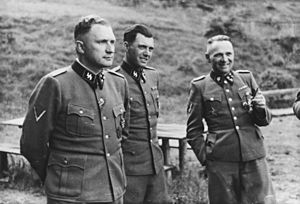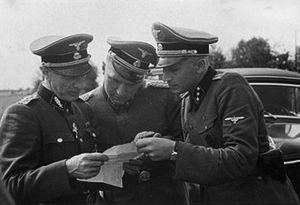Richard Baer facts for kids
Quick facts for kids
Richard Baer
|
|
|---|---|
 |
|
| Born | 9 September 1911 Floß, Kingdom of Bavaria, German Empire
|
| Died | 17 June 1963 (aged 51) |
| Political party | Nazi Party #454,991 (SS #44,225) |
| SS service | |
| Service/ |
Death's Head Units Waffen-SS |
| Years of service | 1933–1945 |
| Rank | SS Major |
| Commands held | commandant in Auschwitz I concentration camp (May 1944-February 1945) commandant in Mittelbau-Dora concentration camp (February-April 1945) |
| Notes | |
|
|
|
Richard Baer (born September 9, 1911 – died June 17, 1963) was a German officer during World War II. He was a leader in the SS, a powerful group in Nazi Germany. Baer was in charge of Auschwitz I concentration camp from May 1944 to January 1945. After that, he was the leader of Mittelbau-Dora concentration camp from February to April 1945. After the war, Baer hid using a different name. However, he was found and arrested in December 1960. He died while being held before his trial could begin.
Contents
Early Life and Joining the SS
Richard Baer was born in Floss, Bavaria, in 1911. He grew up in a Protestant family. In 1925, he moved to Weiden in der Oberpfalz. There, he trained for three years to become a pastry chef. After his training, Baer traveled around Bavaria for several years. In late 1932, he returned to the pastry company where he had trained. He worked there until March 1933.
Baer joined the Nazi Party in 1930. On July 1, 1932, he became a member of the General SS. In his local SS office in Weiden, he met Martin Gottfried Weiss. Weiss later became a concentration camp leader. Baer said he joined the General SS because he liked the "soldier discipline." He also enjoyed "playing soldiers."
Training and Early Assignments
After the Nazis came to power, many SS men in Weiden became local police officers. By April 1933, they were sent to guard the Dachau concentration camp. There, Baer received military training and learned about Nazi ideas. He also learned harsh methods for controlling prisoners. His teacher was Theodor Eicke, who was the camp leader since June 1933. Eicke created the "Dachau Model" for Nazi concentration camps. Baer described the guard training in Dachau as "very strict." He said, "The more we were polished, the more proud we were of it."
From December 1934 to March 1935, Baer guarded the Gestapo prison called Columbia-Haus in Berlin. Later, he joined the SS-Death's Head (SS-TV) 2nd regiment. This group helped build the Sachsenhausen concentration camp in 1936. After taking a course for platoon commanders, Baer served at Buchenwald concentration camp. This was from March to September 1938.
In September 1938, Baer was promoted to SS-second lieutenant (Untersturmführer). By the end of that year, he led the first group of guards at the new Neuengamme concentration camp. At that time, Neuengamme was a smaller camp connected to Sachsenhausen. In September 1940, he became a commando overseer.
War Service and Camp Roles
At the end of 1940, Baer asked to fight on the front lines. After finishing a company commander course, he was sent to the Eastern Front. In December 1941, he was injured and sent back to Neuengamme concentration camp.
In 1942, Baer became an assistant to the leader of the Neuengamme concentration camp. At Neuengamme, he was involved in terrible actions against prisoners.
From November 1942 to May 1944, Baer was an assistant to Oswald Pohl. Pohl was the chief of the SS Main Economic and Administrative Office. In November 1943, Baer took over the Central Office in the Concentration Camps Inspectorate Department. He became the third and final leader of Auschwitz I on May 11, 1944. He remained in this role until the camp was closed in early 1945.
From November 1943 until the end of 1944, Fritz Hartjenstein and Josef Kramer were in charge of the extermination camp at Auschwitz II-Birkenau. So, Baer was only the leader of that part of the camp from late 1944 until February 1945. Near the end of the war, Baer became the leader of the Mittelbau-Dora concentration camp. This camp was in Nordhausen. He was responsible for the mass hanging of Soviet prisoners there. His final rank was SS Major.
After the War
After the war ended, Baer went back to his home area. He eventually settled near Hamburg. He lived under the false name Karl Egon Neumann and worked as a forestry worker. During the investigations for the Frankfurt Auschwitz Trials, an arrest warrant for him was issued in October 1960. His photograph was printed in newspapers.
The story of Baer's arrest is told in a book by Devin Pendas. A co-worker on Otto von Bismarck's estate saw Baer's picture in the newspaper Bild-Zeitung. The co-worker reported that Baer was working there as a forester. When officials found "Neumann" on the morning of December 20, 1960, he first denied everything. The woman in the house had already called Baer her "husband." She then said her name was "Frau Baer" but still claimed Baer's name was "Neumann." However, Baer finally admitted who he really was. On his lawyer's advice, he refused to speak further. He died of a heart attack in 1963 while he was being held before his trial.
See also
 In Spanish: Richard Baer para niños
In Spanish: Richard Baer para niños
- Höcker Album



